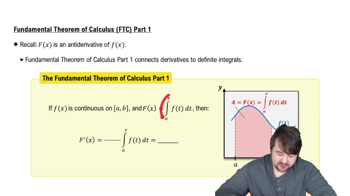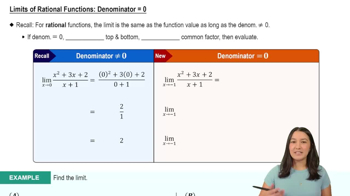If f(1)=5, must limx→1 f(x) exist? If it does, then must limx→1 f(x)=5? Can we conclude anything about limx→1 f(x)? Explain.
Table of contents
- 0. Functions7h 54m
- Introduction to Functions16m
- Piecewise Functions10m
- Properties of Functions9m
- Common Functions1h 8m
- Transformations5m
- Combining Functions27m
- Exponent rules32m
- Exponential Functions28m
- Logarithmic Functions24m
- Properties of Logarithms36m
- Exponential & Logarithmic Equations35m
- Introduction to Trigonometric Functions38m
- Graphs of Trigonometric Functions44m
- Trigonometric Identities47m
- Inverse Trigonometric Functions48m
- 1. Limits and Continuity2h 2m
- 2. Intro to Derivatives1h 33m
- 3. Techniques of Differentiation3h 18m
- 4. Applications of Derivatives2h 38m
- 5. Graphical Applications of Derivatives6h 2m
- 6. Derivatives of Inverse, Exponential, & Logarithmic Functions2h 37m
- 7. Antiderivatives & Indefinite Integrals1h 26m
- 8. Definite Integrals4h 44m
- 9. Graphical Applications of Integrals2h 27m
- 10. Physics Applications of Integrals 3h 16m
- 11. Integrals of Inverse, Exponential, & Logarithmic Functions2h 31m
- 12. Techniques of Integration7h 41m
- 13. Intro to Differential Equations2h 55m
- 14. Sequences & Series5h 36m
- 15. Power Series2h 19m
- 16. Parametric Equations & Polar Coordinates7h 58m
1. Limits and Continuity
Introduction to Limits
Problem 2.2.63
Textbook Question
Using the Sandwich Theorem
If √(5 −2x²) ≤ f(x) ≤ √(5−x²) for −1 ≤ x ≤ 1, find limx→0 f(x).
 Verified step by step guidance
Verified step by step guidance1
Understand the Sandwich Theorem: It states that if a function f(x) is squeezed between two other functions g(x) and h(x) such that g(x) ≤ f(x) ≤ h(x) for all x in some interval, and if the limits of g(x) and h(x) as x approaches a certain value are equal, then the limit of f(x) as x approaches that value is the same.
Identify the functions involved: Here, we have g(x) = √(5 − 2x²) and h(x) = √(5 − x²) with f(x) squeezed between them, i.e., √(5 − 2x²) ≤ f(x) ≤ √(5 − x²).
Determine the limits of g(x) and h(x) as x approaches 0: Calculate limx→0 √(5 − 2x²) and limx→0 √(5 − x²).
Calculate limx→0 √(5 − 2x²): Substitute x = 0 into the expression to find the limit.
Calculate limx→0 √(5 − x²): Substitute x = 0 into the expression to find the limit. Since both limits are equal, apply the Sandwich Theorem to conclude that limx→0 f(x) is equal to this common limit.
 Verified video answer for a similar problem:
Verified video answer for a similar problem:This video solution was recommended by our tutors as helpful for the problem above
Video duration:
2mPlay a video:
Was this helpful?
Key Concepts
Here are the essential concepts you must grasp in order to answer the question correctly.
Sandwich Theorem
The Sandwich Theorem, also known as the Squeeze Theorem, states that if a function f(x) is 'squeezed' between two other functions g(x) and h(x) such that g(x) ≤ f(x) ≤ h(x) for all x in an interval, and if the limits of g(x) and h(x) as x approaches a certain value are equal, then the limit of f(x) as x approaches that value is also equal to that limit.
Recommended video:

Fundamental Theorem of Calculus Part 1
Limit of a Function
The limit of a function describes the value that the function approaches as the input approaches a certain point. In this context, we are interested in finding lim x→0 f(x), which means we need to evaluate the behavior of f(x) as x gets closer to 0, using the bounds provided by the functions √(5 − 2x²) and √(5 − x²).
Recommended video:

Limits of Rational Functions: Denominator = 0
Continuous Functions
A function is continuous at a point if the limit of the function as it approaches that point equals the function's value at that point. In this problem, since the functions √(5 − 2x²) and √(5 − x²) are continuous over the interval [-1, 1], we can confidently apply the Sandwich Theorem to find the limit of f(x) as x approaches 0.
Recommended video:

Intro to Continuity

 6:47m
6:47mWatch next
Master Finding Limits Numerically and Graphically with a bite sized video explanation from Patrick
Start learningRelated Videos
Related Practice
Textbook Question
